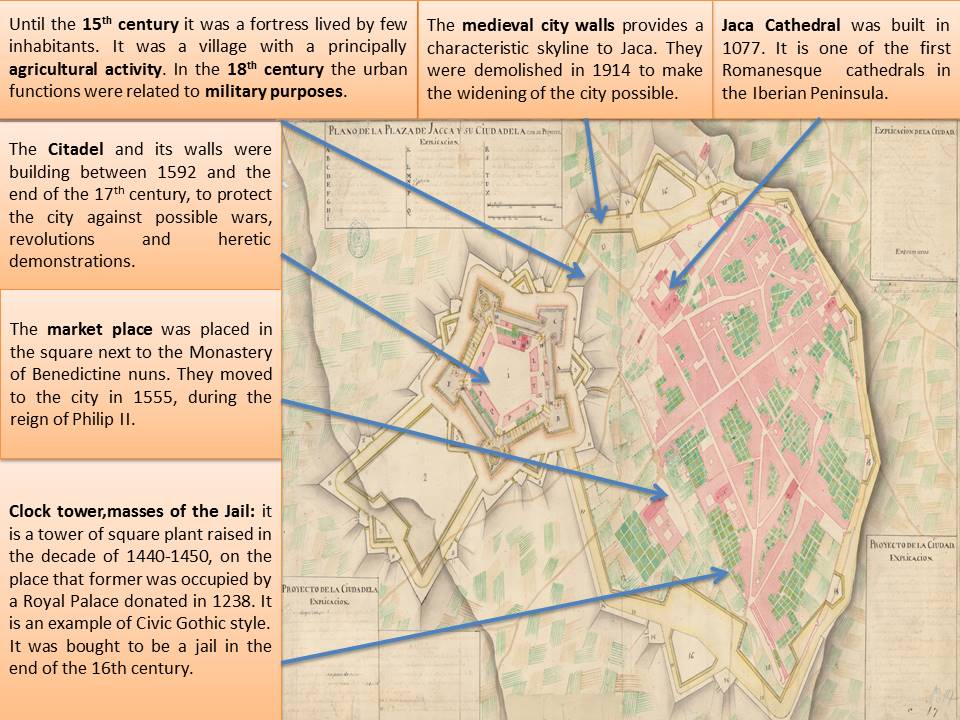JACA (18th century )
This plan represents the city of Jaca (Huesca) in the 18th century. It is a city of northeastern Spain near the border with France, in the midst of the Pyrenees in the province of Huesca. The image centres its attention on The Citadel and the old quarter of Jaca which is a medieval Christian city. It is a manuscript drawn in black ink and colored with water-colours in red, green, grey and yellow. It belongs to the Historical Military Service in Madrid.
In the image we can appreciate that the urban layout is irregular, which is typical in medieval cities, because the streets don’t have a regular order and the squares don’t have a rectangular shape. 25 years ago were realized in Jaca the first archaeological excavations of this urban area, which turned out to be crucial for the later historiography. The findings propitiated the rediscovery of the Jacobean Jaca, which was a very important town in the Middle Ages due to its location in the Way of Saint James. The influence of the Way of Saint James was not only noted in a number of works of art but also in the religious, cultural and economic aspects in relation to this network of peregrination.
It is curious to note that the main square in Jaca was named “castrum” in ancient texts. At the beginning of the 11th century Jaca was a hopscotch or military camp formed by a set of housings with a significant importance thanks to its situation. Furthermore it was one of the most accessible paths to France and a strategic entrance for the Way of Santiago. This is something that can be appreciated in the urban structure of Jaca as we can distinguish two main areas: on the left there is a military fortress, whereas on the right it is possible to see the town itself surrounded by city walls.
King Philip II commissioned the engineer Tiburcio Spanochi to design this fortress which was named the Citadel of Jaca. It was built between 1592 and the end of the 17th century. It is a pentagon with thick slightly inclined stone walls, which are reinforced by a bastion at each point and surrounded by a moat. The most important military activity that has taken place there was during War of Spanish Independence, when it was occupied by French troops between 1809 and 1814. The Citadel, also called Saint Peter’s Castle, now houses the Museum of Military Miniatures with a collection of more than 32,000 pieces.
Another important urban feature is the Cathedral, which was declared a National Monument in 1931. Its construction began in the late 11th century during the reign of Sancho Ramirez. The Cathedral maintains its original Romanesque structure and layout but nowadays the building is the result of constant modification, extension and demolition. Saint Peter’s cathedral is an open book, a voyage through history and evolution of art, from the first expressions of the Romanesque style to the artistic tendencies of the late 18th century.
A remarkable historical event that happened in this city was the death of King Alfonso I. As a consequence, the Kingdoms of Navarra and Aragon were separated and therefore some rivalries arose between them. In 1137 and 1141, fires occurred in some boroughs, so its city walls were reinforced and Jaca began to have an important military role. Due to its geographical situation, Jaca was also a city-market and provided a lot of services for its region. Also, it was like a final stop along the route from Zaragoza to France and the city council received one of the five tolls that travellers had to pay.
Today Jaca is a city that is open to the future. It proclaimed its interest in developing tourism back in 1917 when the city started growing. It is now a modern, cosmopolitan city with a varied cultural life attracting thousands of visitors every year. We should also mention that one of the best season to visit Jaca is winter, due to its offer of winter sports and climbing activities.
More info at: http://www.portalcultura.mde.es/culltural/archivos/
Cristina Servet Alvarado

